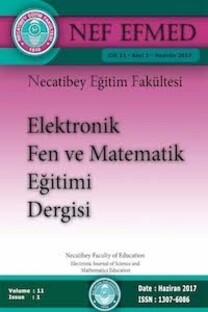QR Kodların Fen Eğitimine Entegresyonu: Öğretmen Görüşleri ve Öneriler
fen eğitimi, teknoloji entegresyonu, QR kod uygulamaları
Use of QR Codes in Science Education: Science Teachers’ Opinions and Suggestions
science education, technology integration, QR Codes,
___
- Aktaş, C. ve Çaycı, B. (2013a). QR kodların eğitim teknolojilerinde kullanımı. International conference on communication, Media, Technology and Design, 375-379.
- Aktaş, C. ve Çaycı, B. (2013b), QR kodun mobil eğitimde yeni eğitim yöntemlerinin geliştirilmesine katkısı. Global Media Journal, 4(7). 1-19.
- Ashford, R. (2010). QR codes and academic libraries: Reaching mobile users, C&RL News, 71(10), 526-530.
- Awano, Y. (2007). Brief pictorial description of new mobile technologies used in cultural institutions in Japan. Journal of Museum Education, 32(1), 17–26.
- Bayrak Meydanoğlu, E.S. (2013). QR code: An interactive mobile advertising tool. International Journal of Business and Social Research, 3(9), 26-32.
- Bonifacio, V.D.B. (2012). QR-coded audio periodic table of the elements: A mobile-learning tool. Journal of Chemical Education, 89(4), 552-554.
- Bozkurt, A. (2015). Mobil öğrenme: Her zaman, her yerde kesintisiz öğrenme deneyimi. Açıköğretim Uygulamaları ve Araştırmaları Dergisi, 1(2), 65-81.
- Bull, G., & Bell, R.L. (2008). Education technology in the science classroom. In R.L. Bell, J. Gess-Newsome, & J. Luft (Eds.), Technology in the Secondary Science Classroom (pp.1-7). Arlington, VA: NSTA Press.
- Canbazoğlu Bilici, S., Tekin, N., &, Karahan, E. (2016). Öğretmen adaylarının fen laboratuarında QR kodlarla zenginleştirilmiş poster kullanımları. 3. Uluslararası Avrasya Eğitim Araştırmaları Kongresi, 31 Mayıs-3 Haziran, Muğla.
- Chaisatien, P., & Akahori, K. (2006). Introducing QR code in classroom management and communication via mobile phone application system. Proceedings of World Conference on Educational Multimedia, Hypermedia and Telecommunications, Association for the Advancement of Computing in Education, Chesapeake, V A. 2181–2187.
- Chaisatien, P. & Akahori, K. (2007). An application on 3g mobile phone and two dimension barcode in classroom communication support system. In C. Montgomerie & J. Seale (Eds.), Proceedings of EdMedia: World Conference on Educational Media and Technology 2007 (pp. 3320-3329). Association for the Advancement of Computing in Education (AACE).
- Chen, X. & Choi, J. (2010). Designing online collaborative location-aware platform for history learning. Journal of Educational Technology Development and Exchange, 3(1), 13-26.
- Coleman, J. (2011) QR codes: What are they and why should you care?. Kansas Library Association College and University Libraries Section Proceedings. 1(1), 16-23.
- Çataloğlu, E., & Ateşkan,A. (2014). QR (Quick Response) kodunun eğitim ve öğretimde kullanımının örneklenmesi. İlköğretim Online, 13(1), 5-14.
- Deloitte (2013). The state of the global mobile consumer, 2013: Divergence deepens. 3 Ekim 2016 tarihinde http://www2.deloitte.com/content/dam/Deloitte/global/Documents/Technology-Media-Telecommunications/dttl_TMT-GMCS_January%202014.pdf adresinden indirilmiştir.
- Ertmer, P.A., Addison, P., Lane, M., Ross, E., & Woods, D. (1999). Examining teacher beliefs about the role of technology in the elementary classroom. Journal of Research on Computing in Education, 32(1), 54-72.
- Gradel, K., & Edson, A. (2012). Qr codes in higher education: Fad or functional tool?. Journal of Educational Technology Systems, 4(1), 45-67.
- Işık, D. (2013). Üniversite kütüphanelerinde Web 2.0 teknolojilerinin kullanımı ve Web tabanlı kullanıcı eğitimi için öneriler. Türk Kütüphaneciliği, 27(1), 100-116.
- Karahan, E. & Roehrig, G. (2016). Use of Web 2.0 technologies to enhance learning experiences in alternative school settings. International Journal of Education in Mathematics, Science and Technology, 4(4), 272-283.
- Law, C., & So, S. (2010). QR codes in education. Educational Technology Development and Exchange, 3(1), 85-100.
- Liu, T., & Tan, T. (2007). 2D barcode and augmented reality supported english learning system. The 6th IEEE/ACIS International Conference on Computer and Information Science (ICIS 2007)
- Miles, MB. & Huberman, AM. (1994). Qualitative data analysis (2nd edition). Thousand Oaks, CA: Sage Publications.
- Özdamlı, F., & Uzunboylu, H. (2015). M-learning adequacy and perceptions of students and teachers in secondary schools. British Journal of Educational Technology, 46(1), 159-172.
- Pons, D., Valles, R., Abarca, M., & Rubio, F. (2011). QR codes in use: The experience at UPV Library. Serials, 24(3), 47-56.
- Ramsden, A., & Jordan, L. (2009). Are students ready for QR codes? Findings from a student survey at the University of Bath. Working Paper. University of Bath.
- Rouillard, J. (2008). Contextual QR codes. Proceedings of the Third International Multi Conference on Computing in the Global Information Technology. ICCGI 2008. July 27 - August 1, 2008 -Athens, Greece.
- Saran, M. (2013). Mobil öğrenme: Fırsatlar ve zorluklar. K. Çağıltay, Y. Göktaş (Ed.). Öğretim teknolojilerinin temelleri: Teoriler araştırmalar, eğilimler içinde (s.697-711). Ankara: Pegem Akademi.
- So, S. (2011). Beyond the simple codes: QR in education. In G. Williams, P. Statham, N. Brown & B. Cleland (Eds.), Changing Demands, Changing Directions. Proceedings ascilite Hobart 2011. (pp.1157-1161).
- Strauss, A., & Corbin, J. (1990). Basics of qualitative research: Grounded theory procedures and techniques. Newbury Park, CA: Sage Publications, Inc.
- Susono, H., Shimomura, T. (2006). Using mobile phones and QR codes for formative class assessment: Current Developments in Technology-Assisted Education, 2, 1006-1010.
- Tarımer, İ. ve Okumuş, İ. T. (2010). Mobil iletişim cihazlarının eğitim aracı olarak kullanılması, Akademik Bilişim Konferansı (AB 2010), Muğla, 67–72.
- Yıldırım, M. ve Bayraktar, C. (2014). İşletmelerde otomasyon ve barkod sistemleri ve muhasebe süreçlerine katkıları. Uluslararası İşletme ve Yönetim Dergisi, 2(1), 38-48.
- Yin, R. K. (2003). Case study research: Design and methods (3rd ed.). Thousand Oaks, CA: Sage.
- Zhao, Y. (2003). What teachers need to know about technology?: framing the question. In Y. Zhao (Ed.), What should teachers know about technology?: Perspectives and practices (pp. 1-14). Greenwich, CO: Information Age Publishing.
- ISSN: 1307-6086
- Yayın Aralığı: 2
- Başlangıç: 2007
- Yayıncı: Balıkesir Üniv. Necatibey Eğitim Fak.
Öğrenme Sorumluluğu Ölçeğinin Geliştirilmesi
İBRAHİM KEPCEOĞLU, İLYAS YAVUZ
Şule SARIBAŞ, Yaşare AKTAŞ ARNAS
EMRE YILDIZ, ÜMİT ŞİMŞEK, Hakan ARAS
Middle School Mathematics Teachers’ Opinions on Estimation
SAFURE BULUT, BURÇAK BOZ YAMAN
EDA ERDAŞ KARTAL, NİHAL DOĞAN, SELDA YILDIRIM
Mathematics Examination Anxiety Scale for Middle School Students: A Scale Development Study
